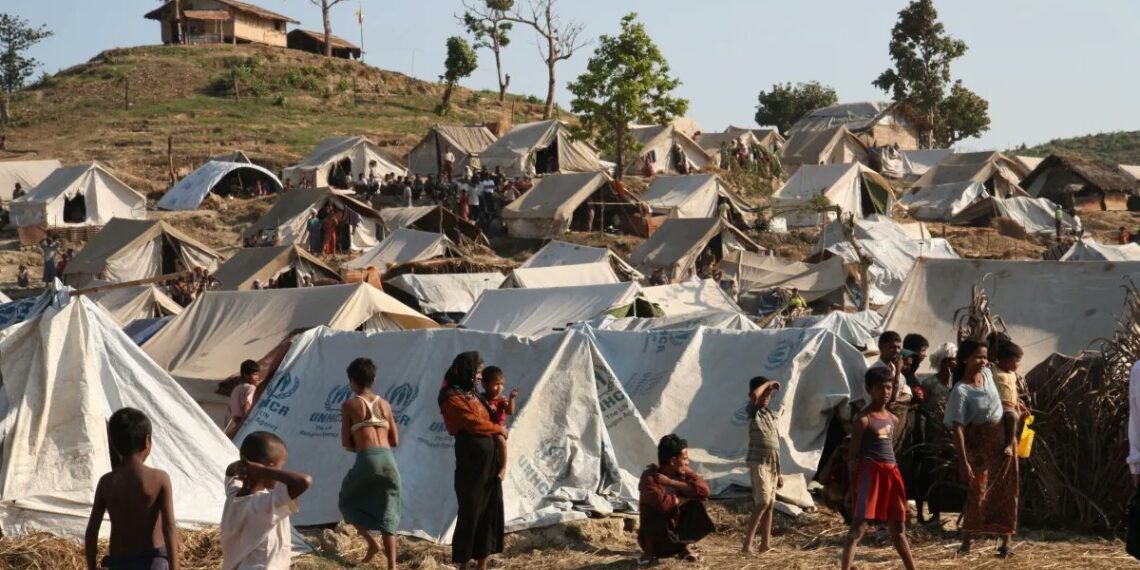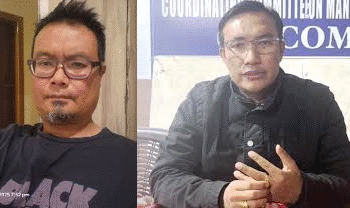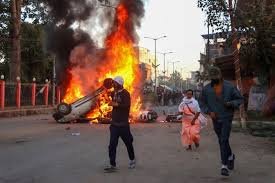Over 6,000 Myanmar refugees, mostly from the Chin ethnic community, have entered Mizoram following violent clashes between rival pro-democracy militias across the border. The Chin National Army’s seizure of a CNDF base has triggered a fresh humanitarian crisis.
By Navin Upadhyay
July 7, 2025—In a troubling escalation of internal conflict among Myanmar’s Chin pro-democracy forces, armed clashes between rival Chin ethnic insurgent groups have displaced thousands, reigniting a humanitarian crisis along India’s eastern frontier. Over 7,000 refugees have crossed into Mizoram over the past week after the Chin National Army (CNA) reportedly overran the headquarters of the Chin National Defence Force (CNDF) at Camp Rihli, just across the Indo-Myanmar border.
While Myanmar’s civil war has been raging since the February 2021 military coup, this particular conflict does not involve the junta — but a violent fracture within the ethnic Chin resistance itself.
A Fragile Brotherhood Breaks
The fighting, which first flared up on June 5 in Zokhawthar — a border town in Myanmar adjacent to Champhai district in Mizoram — has pitted the CNDF and Chinland Defence Force (CDF) against the CNA, the armed wing of the influential Chin National Front (CNF). All factions claim to represent Chin nationalism and anti-regime resistance, but growing competition over strategic territory and political legitimacy has turned former allies into adversaries.
READ: The Mate Case (Part 5): Why SC Must Go for UAPA Bail Reform
The immediate flashpoint appears to be the town of Khawmawi, a small yet strategically vital trading post on the Myanmar-Mizoram border. Control over such locations not only enables access to resources and movement of troops but also gives political clout within the wider resistance movement. On June 5, the CNDF reportedly seized eight camps from the CDF, forcing their rivals out of Khawmawi. In retaliation, CNA forces launched an assault on Camp Rihli, a key CNDF stronghold, on July 6.
“The CNA’s seizure of Camp Rihli is not just retaliation — it’s a clear message about who controls Chinland’s western frontier,” a senior analyst tracking Myanmar’s civil war told The Telegraph. “What we’re witnessing is a tragic unraveling of the Chin resistance from within.”
“We Were Preparing Lunch, They Took the Camp”
According to a report in The Irrawaddy, the CNDF claims it was caught completely off guard. According to its spokesperson, Salai Timmy Htut, the CNA arrived at their headquarters under the pretext of negotiation and later launched a surprise takeover.
READ: Exclusive: Manipur SoO Talks Hit Snag as ZRA Plays Spoilsport
“We didn’t stop them because we thought they weren’t involved in our dispute with CDF-Hualngoram,” Htut said. “Our chief of staff was negotiating. We were even preparing to host lunch for them when they took control of our headquarters. Another column is now marching toward Falam town, which is under Chin Brotherhood control.”
Falam is a key administrative and cultural hub in Chin State — and control of it would signify a major shift in internal power dynamics among Chin factions.
Humanitarian Toll on Mizoram
As bullets fly across the Tiau River, Mizoram has once again become a sanctuary for ethnic kin fleeing conflict. The Zokhawthar Village Council Secretary Lalrawnkima has said that over 4,000 adult refugees have been registered in just three days. Since registration applies only to adults, the actual number of displaced people, including women and children, is estimated to be around 7,000.
“Every household in Zokhawthar is sheltering 25 to 30 people. Churches and community halls are overflowing. Our resources are stretched, but people are still arriving,” Lalrawnkima told The Telegraph.
Further east, over 700 more refugees have reportedly arrived in Saikhumphai, another village bordering Myanmar, according to local civil society leaders in Vaphai.
A recently circulated video reveals a distressing scene: hundreds of citizens from Myanmar, including vulnerable elderly individuals and children, are fleeing Rihkhawdar, a border town to Mizoram state. This mass migration is driven by a sudden and aggressive attack from the Chin… pic.twitter.com/KOdmVyoMY4
— Chindwin News Agency (@TheChindwin) July 7, 2025
Mizoram’s Quiet Resilience
Despite being a small and resource-constrained state, Mizoram has consistently responded with compassion to refugee influxes from Myanmar, dating back to 2021. Mizoram Home Minister K. Sapdanga reaffirmed the state’s commitment to aiding the displaced.
“The Mizoram government will do everything within its capacity — not just because they are our ethnic kin, but because it is our moral and humanitarian duty,” he said.
READ: Tribals Show the Way in Manipur, Hill Districts Lead Peace and Justice Index
The state government, in collaboration with local NGOs such as the Central Young Mizo Association (CYMA), is now working to mediate between the warring Chin factions. Chief Minister’s political adviser Lalmuanpuia Punte has been roped in to lead the informal peace initiative.
“Dialogue, not infighting, is the need of the hour,” a CYMA official said. “The junta will only benefit from this disunity.”
Anatomy of a Split
The CNDF and CDF are part of the Chin Brotherhood, a six-member alliance that also includes the Chin National Organization. Formed as a resistance front post-coup, the Brotherhood has tried to maintain its independence from the older, more established Chin National Front (CNF), whose political and military arms — including the CNA — now dominate the Chinland Council, an umbrella formed in late 2023. The Council includes the CNF/CNA, ousted Chin MPs, and other anti-junta entities.

But the uneasy coexistence between these two coalitions has eroded. While both claim to resist the military regime in Naypyidaw, territorial competition, ideological rifts, and external alliances have turned the struggle for freedom into a contest for control.
“The larger tragedy is that both the Chinland Council and the Chin Brotherhood were supposed to unify the resistance,” said an academic who has studied ethnic insurgency in the region. “Instead, it’s deepening fragmentation. The more divided the Chin forces become, the harder it will be to build a federal democratic future for Myanmar.”
Ongoing armed clashes between CNDF & HPO in Myanmar’s Chin State triggered a renewed wave of displacement. As of today,at least 3,618 refugees, including children,have crossed over into Zokhawthar.
Yesterday, the border gate was closed&today a limited time window was given for – https://t.co/3EQjtu57g5 pic.twitter.com/6uKXyXeEXA— miZO zEITGEIST (@mizozeitgeist) July 7, 2025
A Warning from History
Myanmar’s post-colonial history is riddled with ethnic resistance movements that collapsed due to internal fragmentation. Observers warn that the Chin conflict could mirror the fate of the Kachin, Karen, or Wa movements — whose once-powerful insurgencies eventually split into competing factions, undermining their long-term goals.
“The Chin are a proud people with a strong tradition of resistance, but they’re now at a crossroads,” said a senior retired Indian security official familiar with the region. “If they can’t find unity, their political and military leverage — even in future negotiations with the junta or democratic forces — will be seriously weakened.”
As thousands of displaced Chin refugees find temporary shelter across Mizoram’s border villages, the ground reality is stark: a united cause has turned into an internecine struggle, dragging in civilians, exhausting local communities, and weakening the resistance’s credibility.
For now, the only hope lies in successful mediation by community organisations and pressure from cross-border sympathisers. But the longer the guns remain unsilenced, the harder it becomes to restore trust.













